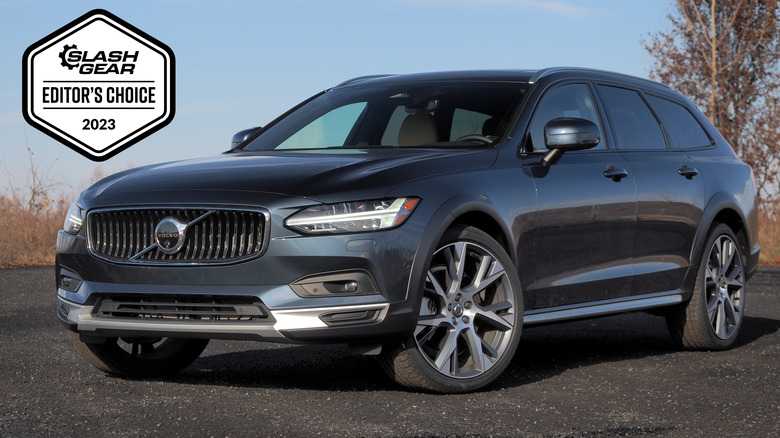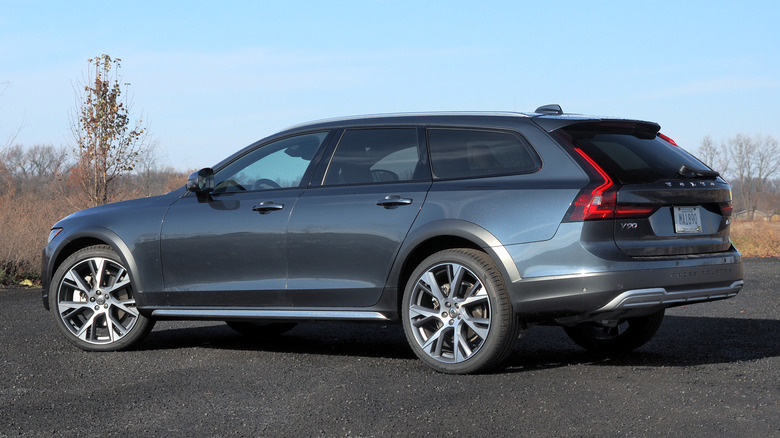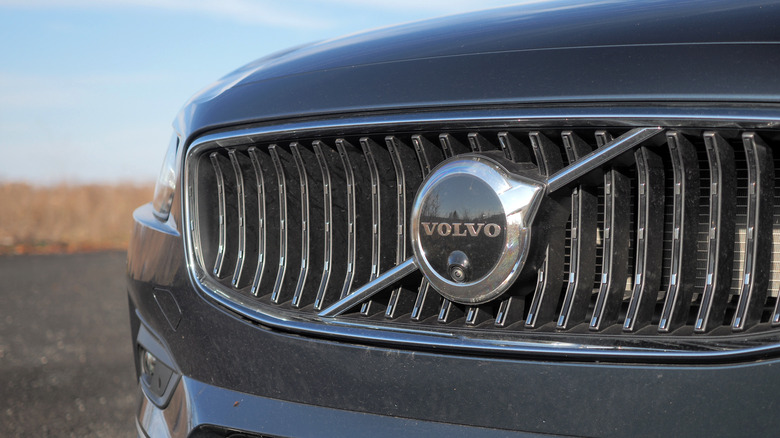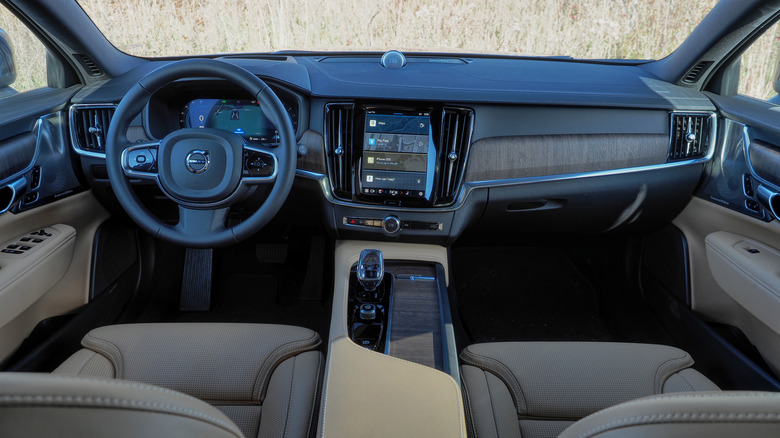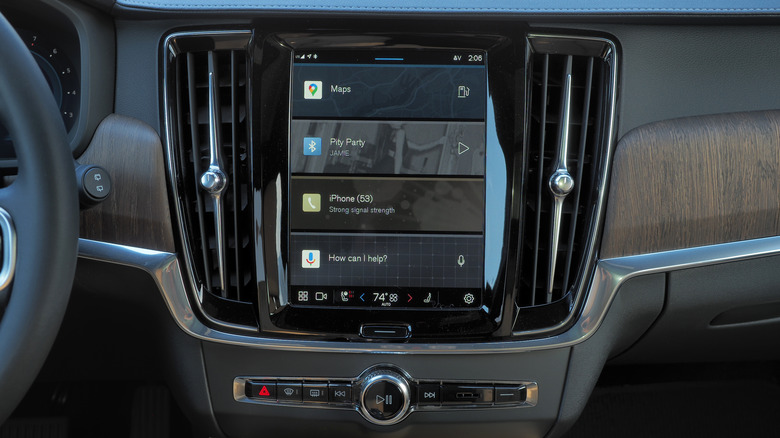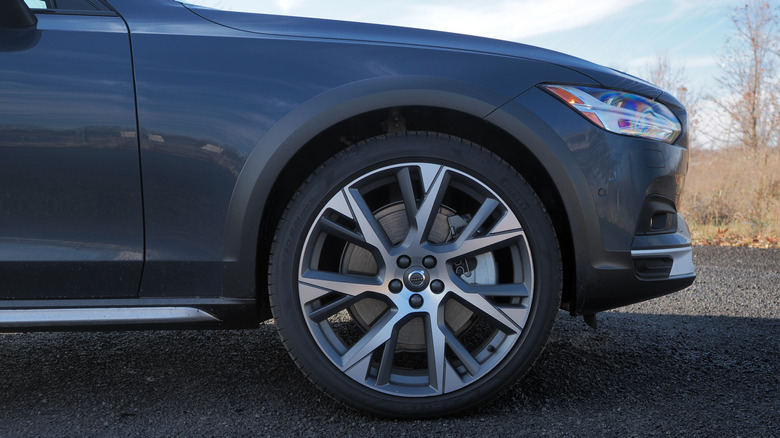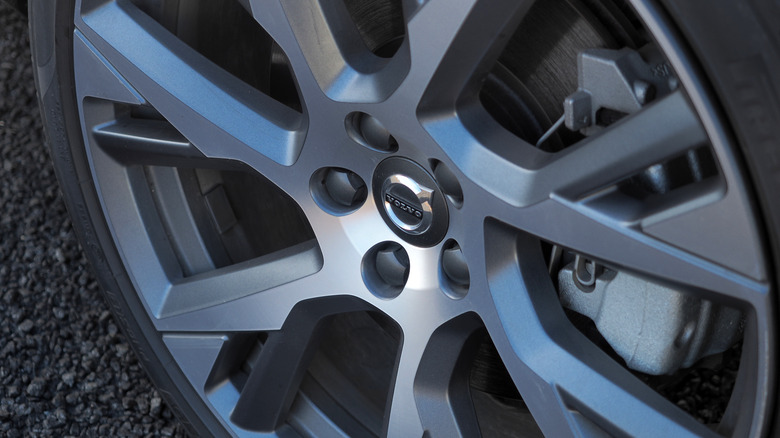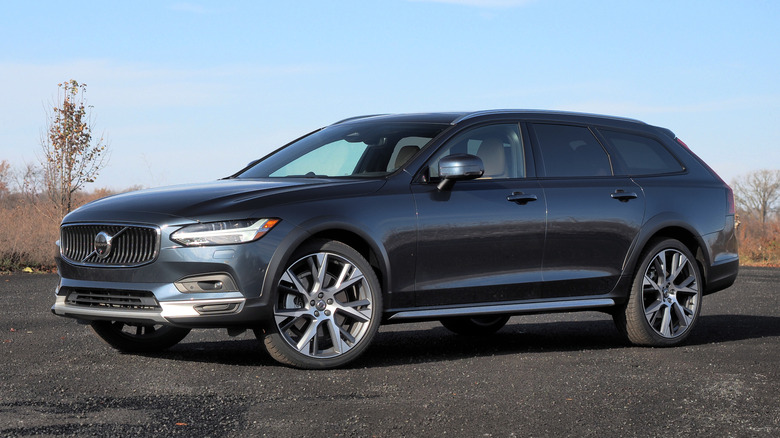2024 Volvo V90 Cross Country Review: You Don't Need An SUV
- Stately, elegant looks are timelessly handsome
- Smooth powertrain and cosseting ride
- SUV-levels of practicality
- Genuine rarity
- Dip in ground clearance from previous model years
- Mild-hybrid could be more frugal
- Some infotainment annoyances
With genuinely "bad" cars generally a thing of the past, these days, a purchase decision can come down to feelings more than features. Certainly, price plays a big role, along with running costs and practicality, but equally important is how a new vehicle tickles you emotionally when you're behind the wheel (or just glancing back at it in a parking lot).
Like most automakers, Volvo is busy reinventing its range for an all-electric future. More accurately, though, it's reinventing a certain category of its cars for that future. With SUVs and crossovers already making the lion's share of new vehicle sales, you'd be forgiven for assuming there's no place for anything else in today's market.
Fans of the offbeat, however, know Volvo doesn't just have electric SUVs to play with right now. The 2024 V90 Cross Country may not be new, in either the grand scheme of electrification or just Volvo's current line-up, but as outliers go, it's an unexpectedly charming one.
More than just an SUV alternative
The Cross Country badge predates the avalanche of SUVs and their dominance in the market (in North America particularly), having first appeared in 1997 on a variant of the Volvo V70. The automaker's recipe hasn't much changed in the 25+ years since: take a nice, practical wagon, give it a suspension lift and all-wheel drive, and add some rough'n'tumble bodywork suitable for the sort of gentle off-roading most drivers will ever need to undertake.
In more recent years, cars like the V90 Cross Country and its smaller V60 Cross Country sibling have hedged Volvo's bets in a market reluctant to consider true wagons. With a sheen of crossover utility (and stance), they've done what rivals like the Audi A6 Allroad and the Mercedes-Benz E-Class All-terrain similarly attempt: demonstrate — albeit to a small audience — that not only isn't an SUV the only route to practicality but that there are advantages in something lower and sleeker, too.
That may all be true, but Volvo isn't oblivious to customer whims. The original V90 wagon is no longer on offer in North America, a victim of dwindled demand, while the V90 Cross Country now comes in just two flavors priced from $60,445 (plus $1,095 destination). It's difficult not to conclude that the Cross Country in its current form is on borrowed time.
Handsome and practical
In an age of oversized grilles, wild proportions, and controversial detailing, the V90's almost subtle elegance feels all the more unusual — and wonderful. Some of that visual restraint is, of course, down to the fact that Volvo has generally left its original aesthetic for the 90 Series well alone. Happily, it was a handsome car to begin with.
At the front, the gently scalloped grille sets the stage for a restrained application of chrome and other brightwork around the exterior. In Cross Country flavor, the wagon rides a little higher, though not by quite as much as it once did. For the 2022 model year and prior, Volvo jacked it up for 8.3 inches of ground clearance. From the 2023 model year on, that has dipped to 7.9 inches.
19-inch alloy wheels are standard on the base Plus trim and 20-inch versions on the Ultimate trim. For $800, the latter can also have 21-inch versions, but as tire sidewall slims, so does off-roading capability. Low-profile aluminum roof rails are standard, in case you need more space beyond the 25.2 cu-ft trunk (which expands to 69 cu-ft with the rear seats folded). The wagon's lower floor level compared to a similarly capacious SUV is particularly welcome.
Old-school lavish
Inside, that sense of familiarity continues. While Volvo may be flirting with new materials, unusual designs, and more sustainable options in its latest electric vehicles — see, for example, the recycled plastics and technical fabrics of the Volvo EX30 EV — the V90 Cross Country feels like a more traditional interpretation of luxury. Leather, wood, and metal all feature strongly, with an overall design that echoes Volvo cars spanning almost a decade.
As with the exterior, though, Volvo hardly needed to depart from what it'd been doing already to make a very pleasant cabin. The metal and wood are real; the leather is supple and wraps deliciously supportive seats. The V90 Cross Country's Orrefors crystal transmission shifter felt like a glittery gimmick when we first saw it: these days, in the face of the gaudy efforts of rivals, it feels positively restrained.
It's not to say Volvo hasn't refined things along the way; it's just that it has been a surreptitious process. The infotainment system is now Android Automotive-based, with native Google Maps, Google Assistant voice control, and Google Play store access. There are native apps for services like Spotify, while a baked-in 4G LTE modem gets four years of complimentary data service.
Two well-equipped versions
For the most part, Volvo's massaging of the V90 Cross Country's systems works out. That's not to say there aren't some head-scratchers. Apple CarPlay support, for example, is included, but only via USB rather than wirelessly; there's no Android Auto support at all. Then there's the 360-degree camera, which — despite only taking up the lower half of the Volvo's 9-inch touchscreen — can't be shown simultaneously with the regular reversing camera.
Still, they're small offenses against what are otherwise two solid trims: Plus, from $60,445, and Ultimate, from $66,045 (both plus destination). Four-zone climate control with air purification, a 12-inch driver display (with admirably restrained graphics), auto wipers, blind spot, and rear cross-traffic alerts, Pilot Assist steering and speed assistance for the highway, front/side/rear parking sensors, a panoramic roof, leather seats with heating in the front, and a hands-free power tailgate are all standard.
To that, Ultimate trim adds a head-up display, nicer Nappa leather upholstery with front seat ventilation and massage, the Orrefors crystal shifter knob, extra power adjustment on the front seats, and a Harman Kardon audio system with a separate subwoofer. The so-good-it's-tough-to-say-no-to-it Bowers & Wilkins Premium Sound upgrade is a $3,200 option.
Just powerful enough
Under the hood, the V90 Cross Country's B6 AWD powertrain falls short of the power that rivals such as the Mercedes-Benz E-Class All-Terrain and Audi A6 Allroad come with. Volvo's 2.0-liter four-cylinder mild hybrid musters 295 horsepower and 310 lb-ft of torque, good for a 0-60 mph time of 6.1 seconds.
The Audi, in contrast, packs 335 hp and 369 lb-ft from its standard V6 and cuts its 0-60 dash to 5.4 seconds. The Mercedes is slightly faster still, taking a quoted 5.3 seconds from its 362 hp and 369 lb-ft. Both will tow more than the Volvo's 3,500-pound rating, too.
The upshot is better fuel economy thanks to two less cylinders, though the official delta here is scant. The EPA says the V90 Cross Country will get 22 mpg in the city, 29 mpg on the highway, and 25 mpg combined (compared to the Audi and Mercedes, each rated at 24 mpg combined). That said, you should still plan on stopping to fill up more frequently in the Swedish wagon: its 15.9-gallon fuel tank is well short of the 19.3-gallon and 21.1 gallons in the Audi and Mercedes, respectively.
No pretense of being a sports wagon
In practice, I saw just over 23 mpg from the Volvo from my own mixed driving, though that could be a side-effect of how pleasant it is to put your foot down. While it may not be the most potent of the jacked-up wagons, the V90 Cross Country's smooth power delivery and firm-but-not-too-firm suspension make for a comfortable executive cruiser. Four corner adaptive air springs are a $1,200 option, useful not only for balancing out ride height and load but also for adjusting according to the road surface.
Volvo doesn't mess with a whole bevy of drive modes, mind. Dig into the settings pages, and you'll find an Off-Road setting, but generally, the V90 Cross Country plays a single song and does that well. Its combination of mechanical and electric boost all synchronize nicely, only spoiled by a slight sluggishness by the eight-speed automatic transmission to downshift if you surprise it with a sudden demand for full acceleration.
2024 Volvo V90 Cross Country Verdict
In an age where we expect our SUVs to be sports cars and luxury vehicles, too, the V90 Cross Country's restrained intent seems positively refreshing. No, it's not the most powerful wagon nor the fastest. Neither — however curious such a thing would be — is it part of Volvo's latest fully-electric vehicle strategy. Indeed, with a mere 515 examples sold this year as of November, it's hard to imagine the automaker prioritizing an EV replacement any time soon.
That's a shame, just like it's a shame that the V90 Cross Country doesn't get more attention in its current form. As nice as an XC90 is, there's something to be said for the sleek styling and planted ride of a lower wagon; you sacrifice less than an inch of ground clearance, too, compared to an XC90 on its standard steel springs.
Harder to quantify and yet no less compelling, though, is how the V90 Cross Country feels — or, perhaps more accurately, how you feel driving it. It's grown-up and refined, with classic, graceful looks and thoughtful technology that doesn't stumble into ostentatious gadgetry. Clearly, that doesn't make it the car the mass market is looking to buy today, but for those in the know and willing to step off the crossover conveyor, this handsome Volvo is an experience as special as it is rare.
